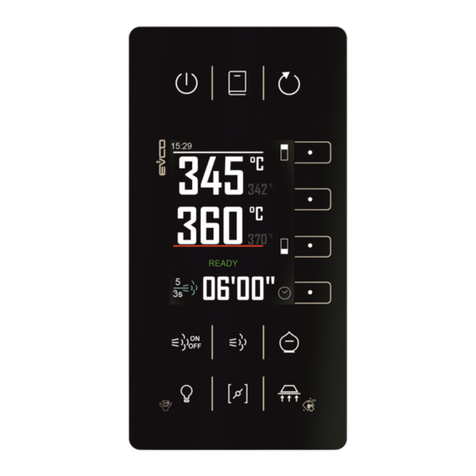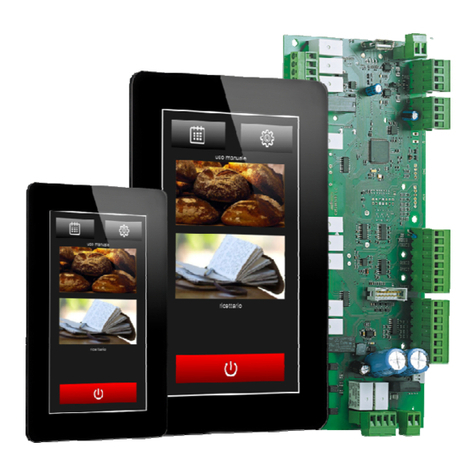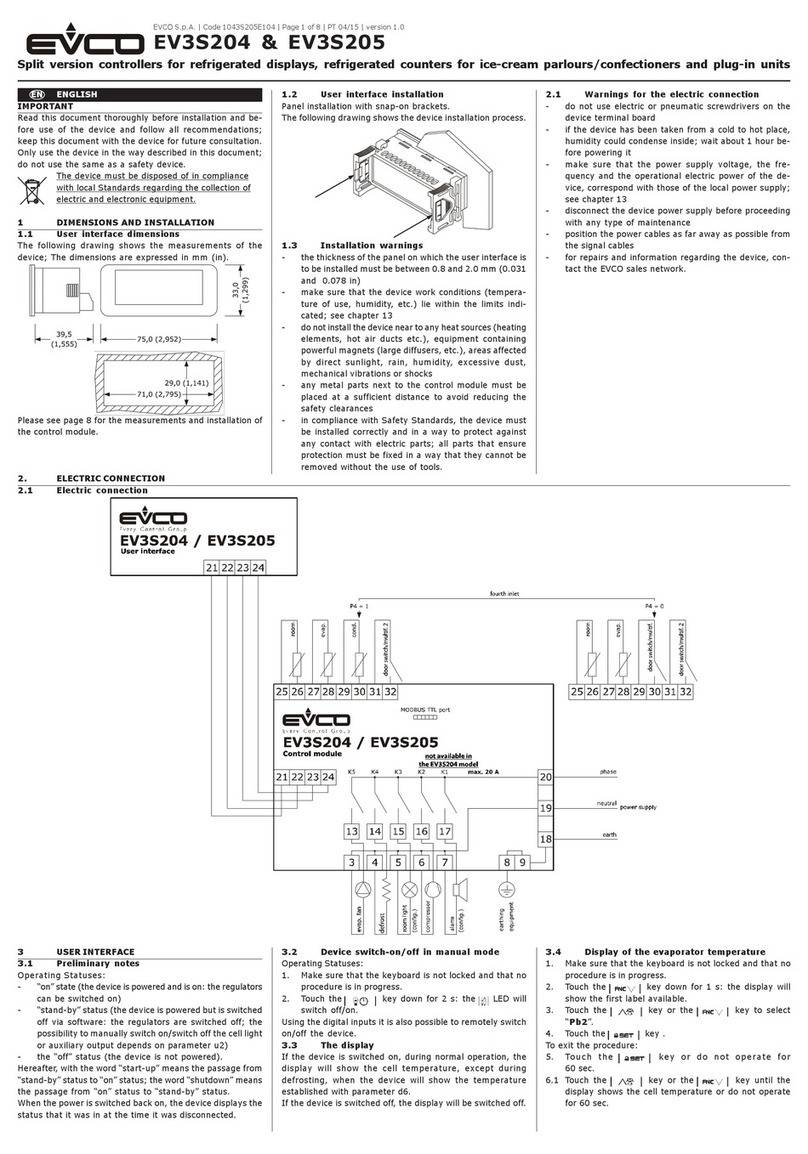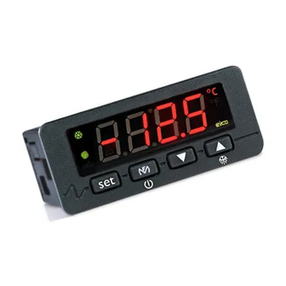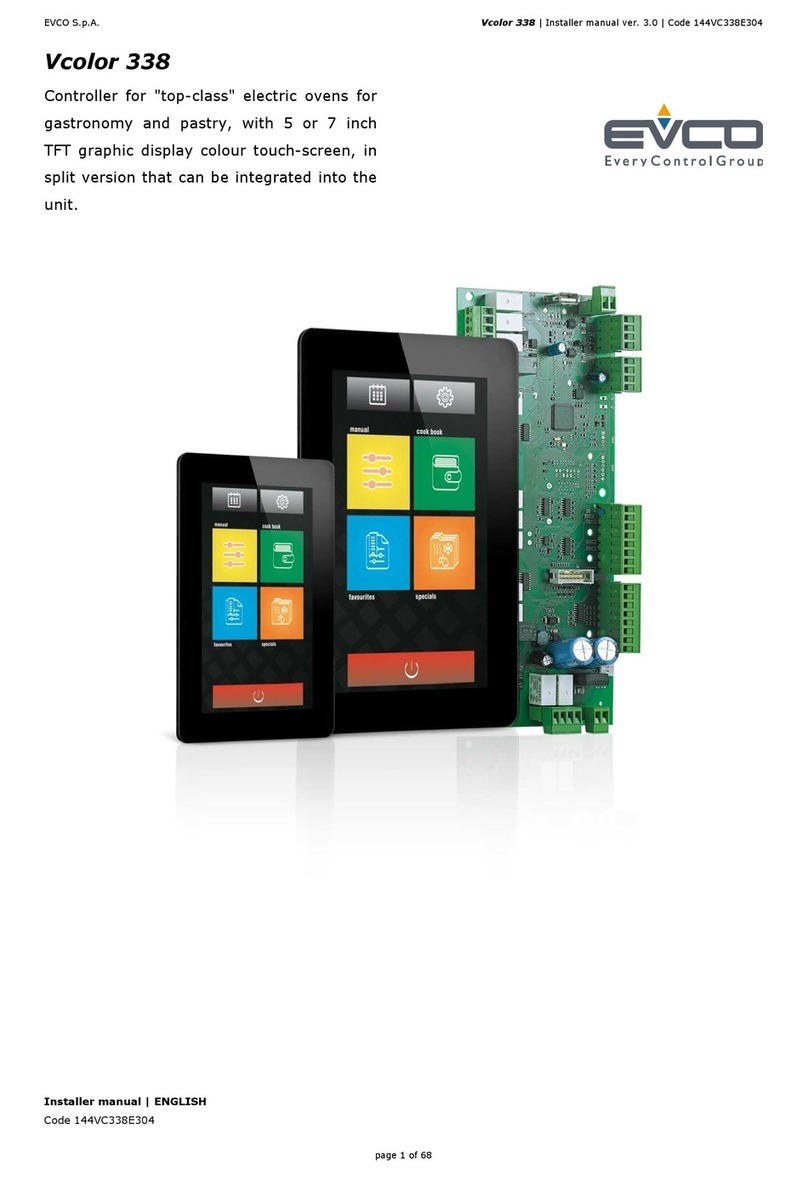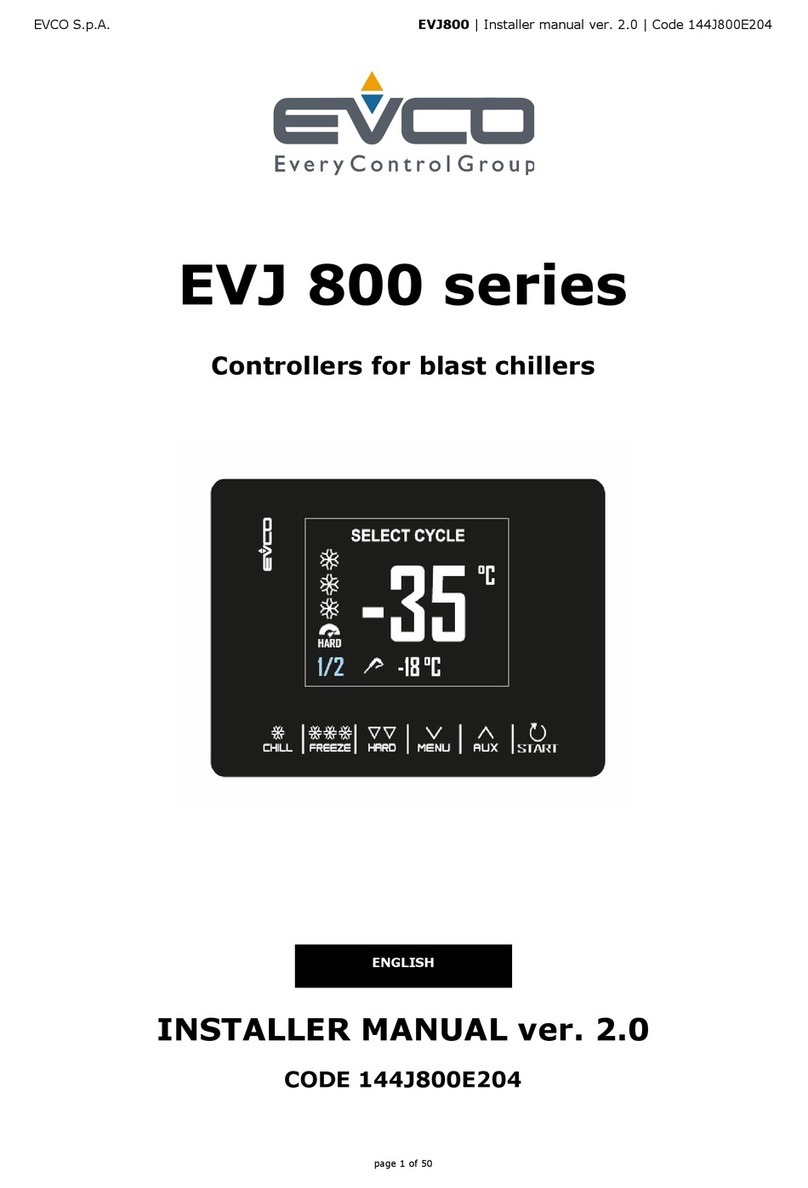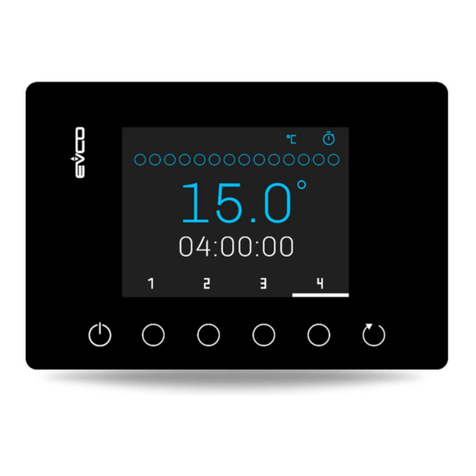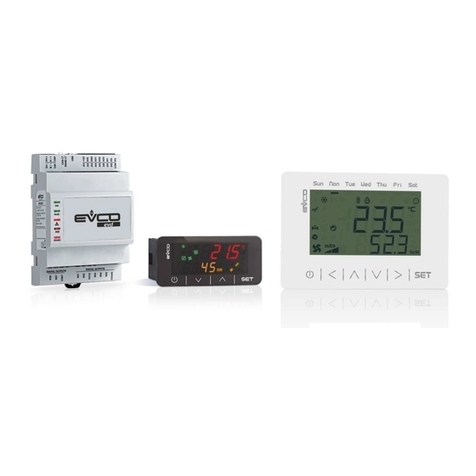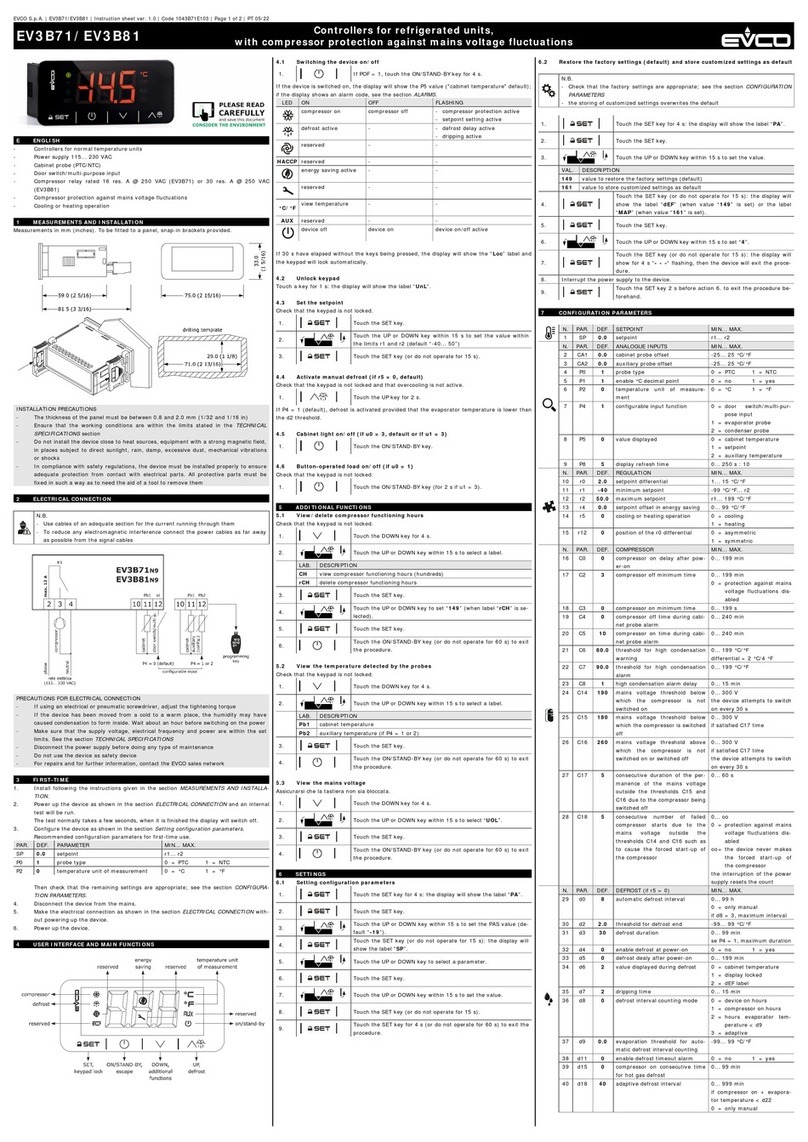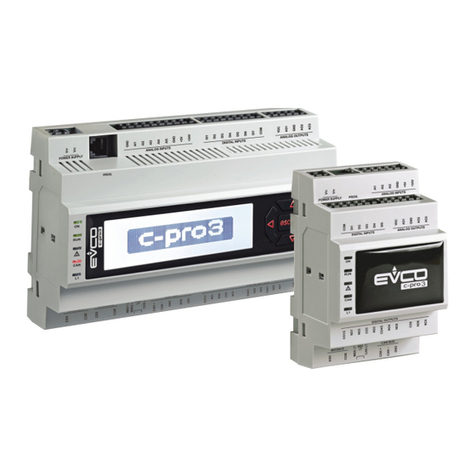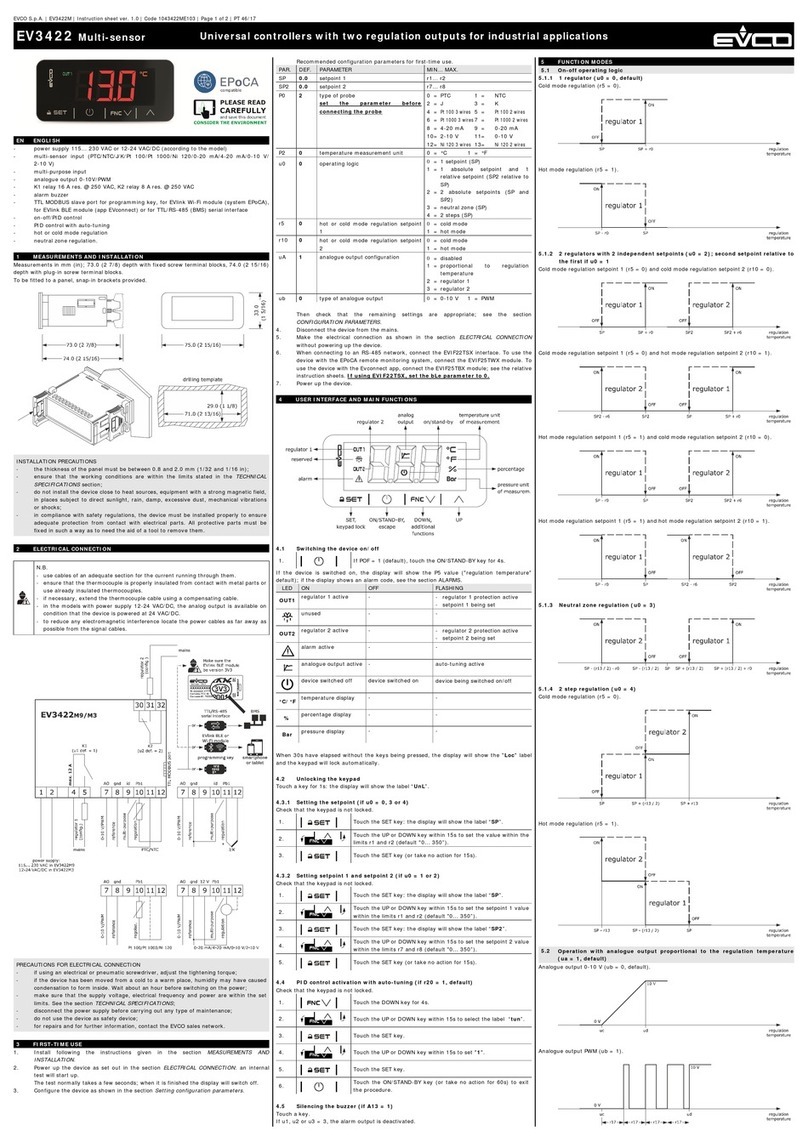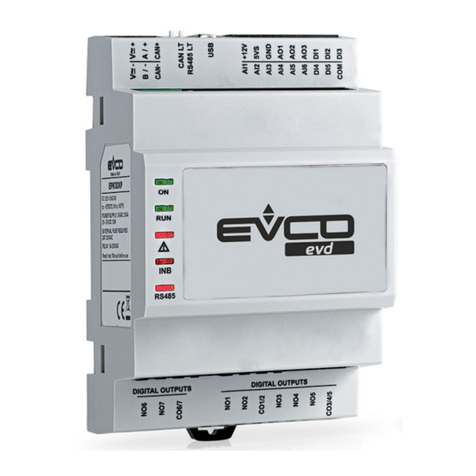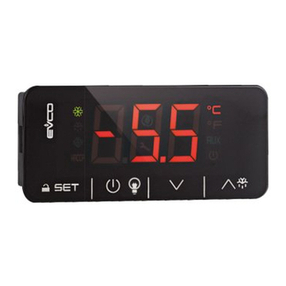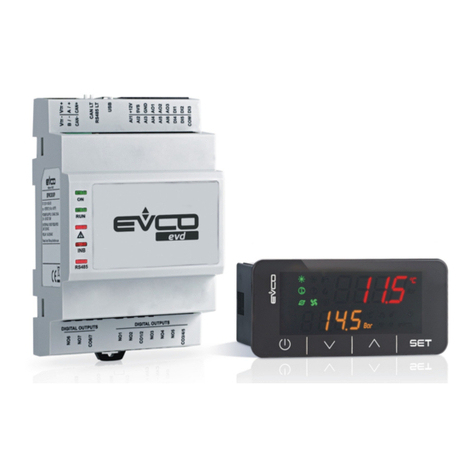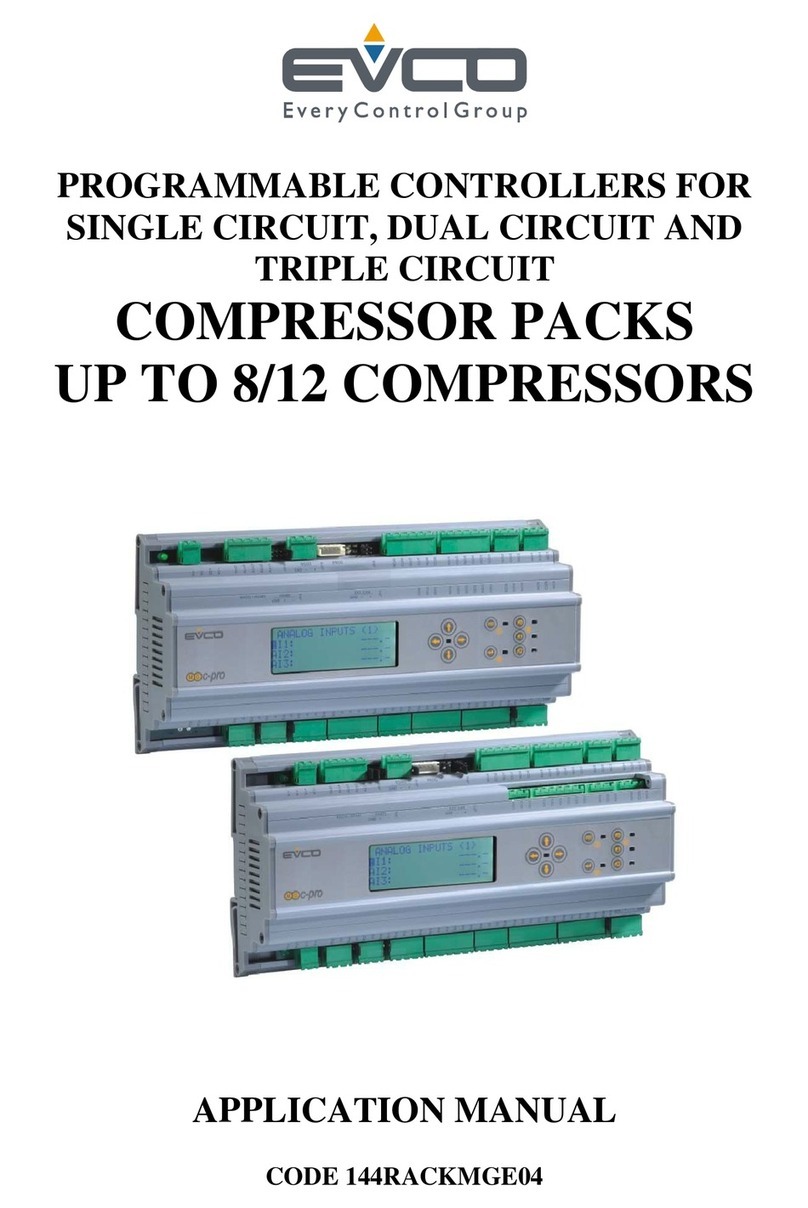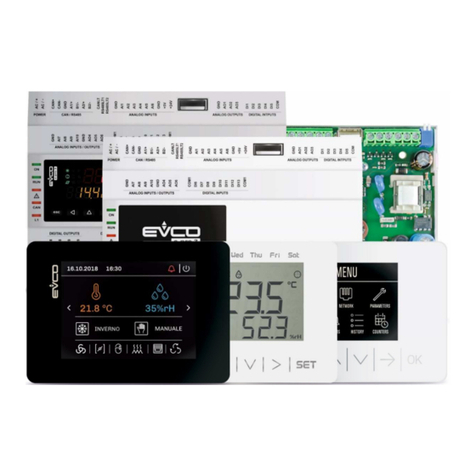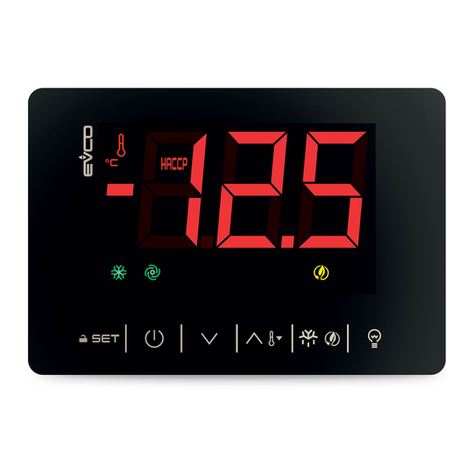
EVCO S.p.A. • Code 104X225E104 • page 2/5
To unlock the keyboard:
• press and hold down the DOWN and ON/STAND-BY keys for 1
sec: the display will show the message “UnL” for 1 sec.
4.13 Silencing the buzzer
• ensure that no other procedure in is progress
• press a key (the first pressing of the key will not cause the effect asso-
ciated with that key).
If parameter u11 is set to 3 and parameter u4 is set to 1, pressing the
key will also disactivate the alarm output.
If parameter u9 is set to 0, the buzzer will not be activated.
5 SETTINGS
5.1 Setting the first working setpoint (room 1)
• ensure that the keyboard is not locked and that no other procedure
is in progress
• press and release the SET key: the room 1 LED will flash
• press and release the UP or DOWN key within 15 sec; see also
parameters r1, r2 and r3
• do not operate for 15 sec: the room 1 LED will switch off and then
the instrument will exit the procedure.
The first working setpoint can also be set via parameter SP1.
5.2 Setting the second working setpoint (room 2)
• press and release the SET key during the modification of the first
working setpoint: the room 2 LED will flash
• press and release the UP or DOWN key within 15 sec; see also
parameters r7, r8 and r9
• press and release the SET key or do not operate for 15 sec: the room
2 LED will switch off and then the instrument will exit the procedure.
The second working setpoint can also be set via parameter SP2.
5.3 Setting the configuration parameters
To begin the procedure:
• ensure that no other procedure is in progress
• hold down the UP and DOWN keys for 4 sec: the display will show
“PA”
• press and release the SET key
• press and release the UP or DOWN key within 15 sec to set “-19”
• press and release the SET key or do not operate for 15 sec
• hold down the UP and DOWN keys for 4 sec: the display will show
“SP”.
To select a parameter:
• press and release the UP or DOWN key.
To change a parameter:
• press and release the SET key.
• press and release the UP or DOWN key within 15 sec.
• press and release the SET key or do not operate for 15 sec.
To exit the procedure:
• hold down the UP and DOWN keys for 4 sec and do not operate
for 60 sec (any changes will be saved).
After changing the parameters, suspend power supply flow
to the instrument.
5.4 Restoring the manufacturer’s settings
To begin the procedure:
• make sure that no other procedure is in progress.
• hold down the UP and DOWN key for 4 sec: the display will show
“PA”
• press and release the SET key
• press and release the UP or DOWN key within 15 sec to set “149”
• press and release the SET key or do not operate for 15 sec
• hold down the UP and DOWN keys for 4 sec: the display will show
“dEF”
• press and release the SET key
• press and release the UP or DOWN key within 15 sec to set “1”
• press and release the SET key or do not operate for 15 sec: the
display will show “dEF” flashing for 4 sec, after which the instru-
ment will exit the procedure.
• suspend the power supply to the instrument.
To exit the procedure before the operation is complete:
• hold down the UP and DOWN keys for 4 sec during the procedure
(that is, before setting “1”: the settings wil not be restored).
Make sure that the manufacturer’s settings are appropriate
(see chapter 11).
6 CALCULATING COMPRESSOR OPERATION HOURS
6.1 Preliminary notes
The instrument is able to store up to 9,999 hours of compressor op-
eration, after which the number “9999” starts flashing.
6.2 Display of compressor operation hours
• make sure that the keyboard is not locked and that no other opera-
tion is in progress
• press and hold down the DOWN key for 1 sec: the display will show
the first available label
• press and release the UP or down DOWN key to select “CH”
• press and release the SET key.
To exit the procedure:
• press and release the SET key or do not operate for 60 sec
• press and release the UP or down DOWN key until the display
shows the temperature estabilshed with parameter P5 or do not
operate for 60 sec.
Alternatively:
• press and release the ON/STAND-BY key.
6.3 Cancelling compressor operation hours
• make sure that the keyboard is not locked and that no other proce-
dure is in progress
• press and hold down the DOWN key for 1 sec: the display will show
the first available label
• press and release the UP or DOWN key to select “rCH”
• press and release the SET key
• press and release the UP or DOWN key within 15 sec to set “149”
• press and release the SET key or do not operate for 15 sec: the
display will show a flashing “- - - -” for 4 sec then the instrument will
exit the procedure.
7 WARNING LIGHTS AND DIRECTIONS
7.1 Warning lights
LED MEANING
compressor LED light
if the LED is on, then the compressor is on (one room at
least asks for cooling)
if the LED is flashing:
• compressor protection operation in progress:
- parameters C0, C1, C2
defrost LED
If it is on:
• defrosting is in progress
if it is flashing:
• dripping in progress:
- parameter d7
evaporator fan LED light
If it is on, the evaporator fan is on
If it is flashing, the evaporator fan is disactivated
- parameter F3
cabinet light LED
If it is on, the cabinet light has been switched on (provided
that parameter u11 is set to 0)
multifunction LED light
If it is on:
• the demisting heater is switched on (provided that pa-
rameter u11 is set to 1)
• the auxiliary output has been switched on
(provided that
parameter
u11
is set to 2)
• the condenser fan will be switched on (provided that
parameter u11 is set to 6)
if it is flashing:
• a delay in switching off the condenser fan is in progress:
- parameter F12 (provided that parameter u11 is set to 6)
room 1 LED
if the LED is on, then the room 1 valve is on
if the LED is flashing:
• the first working setpoint is in the process of being
changed (via the procedure described in paragraph 5.1)
if the LED is flashing 1 s every 4 s:
• room 1 has been switched off
room 2 LED
if the LED is on, then the room 2 valve is on
if the LED is flashing:
• the second working setpoint is in the process of being
changed (via the procedure described in paragraph 5.2)
if the LED is flashing 1 s every 4 s:
• room 2 has been switched off
maintenance LED
if on, compressor maintenance is required:
- parameter C10
alarms LED
if on, an alarm or error is in progress
°CCelsius grade LED
if on, the temperatures will be displayed using the Celsius
grade unit of measurement:
- parameter P2
°FFahrenheit grade LED
if on, the temperatures will be displayed using the Fahren-
heit grade unit of measurement:
- parameter P2
on/stand-by LED
if on, the instrument is in stand-by mode
7.2 Signal Descriptions/Explanations
CODE MEANING
Loc the keyboard is locked:
- see paragraph 4.12
the working setpoints are blocked:
- parameters r3 and r9
8 ALARMS
8.1 Alarms
CODE MEANING
AL1 First minimum alarm temperatures (room 1)
Solutions:
• check the room 1 temperature
• refer to:
- parameters A1 and A2
Main consequences:
• the alarm output will be activated (provided that param-
eter u11 is set to 3)
AH1 First maximum temperature alarm (room 1)
Solutions:
• check the room 1 temperature
• refer to:
- parameters A4 and A5
Main consequences:
• the alarm output will be activated (provided that param-
eter u11 is set to 3)
AL2 Second minimum alarm temperatures (room 2)
Solutions:
• check the room 2 temperature
• refer to:
- parameters A11 and A12
Main consequences:
• the alarm output will be activated (provided that param-
eter u11 is set to 3)
AH2 Second maximum temperature alarm (room 2)
Solutions:
• check the room 2 temperature
• refer to:
- parameters A14 and A15
Main consequences:
• the alarm output will be activated (provided that param-
eter u11 is set to 3)
HP High pressure switch input alarm
Solutions:
• verify the cause of the input activation
• see parameters i0, i1 and i2
Main consequences:
• the effect established with parameter i0
•the alarm output will be activated (provided that param-
eter u11 is set to 3)
LP Low pressure switch input alarm
Solutions:
• verify the cause of the input activation
• see parameters i5, i6 and i7
Main consequences:
• the effect established with parameter i5
•the alarm output will be activated (provided that param-
eter u11 is set to 3)
COH Condenser overheated alarm
Solutions:
• check the condenser temperature
• parameter C6 is seen
Main consequences:
•the alarm output will be activated (provided that param-
eter u11 is set to 3)
• if parameter u11 is set to 6, the condenser fan will be
switched on
CSd Compressor blocked alarm
Solutions:
• check the condenser temperature
• parameter C7 seen
• switch off and re-start the instrument: if when the instru-
ment is switched back on, the temperature of the con-
denser is still higher than that established in parameter
C7, disconnect the power supply and clean the con-
denser
Main consequences:
• the compresser and the evaporator fan will be switched
off
• the alarm output will be activated (provided that param-
eter u11 is set to 3)
When the problem that caused the alarm disappears, the instrument
returns to normal function, with the exception of the compressor
blocked by condenser temperature alarm (code “CSd”) which requires
the switching off of the instrument or the temporary suspension of the
power supply.
9 ERRORS
9.1 Errors
CODE MEANING
Pr1 Room 1 probe error
Solutions:
• verify that the probe is a type NTC
• verify that the probe is intact
• verify the instrument-probe connection
• check the room 1 temperature
Main consequences:
• room 1 valve activity will depend on parameters C4 and
C5
• the defrost will not be activated
• the alarm output will be activated (provided that param-
eter u11 is set to 3)
Pr2 Room 2 probe error
Solutions:
• room 2 valve activity will depend on parameters C4 and
C5
Main consequences:
• the same as the preceeding case
Pr3 Condenser probe error
Solutions:
• the same as the preceeding case but with respect to the
condenser probe
Main consequences:
• condenser overheated alarm (code “COH”) will never
be activated
• compressor blocked by condenser temperature alarm
(code “CSd”) will never be activated
• the alarm output will be activated (provided that param-
eter u11 is set to 3)
PT • 08/12




